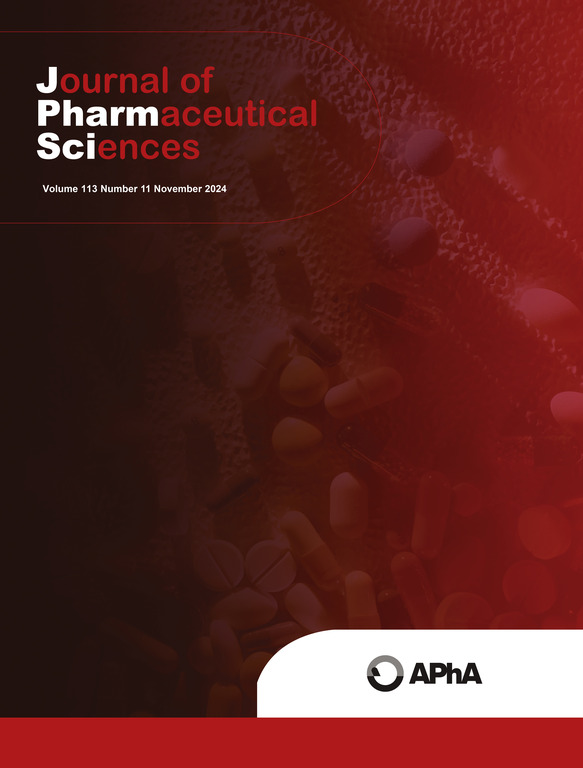载体对喷雾干燥分散体体外和体内性能的影响
IF 3.7
3区 医学
Q2 CHEMISTRY, MEDICINAL
引用次数: 0
摘要
在早期药物开发过程中,用于提高水溶性差的化合物生物利用度的无定形喷雾干燥分散体(SDDs)通常以悬浮液的形式通过口服给临床前物种用药。液体制剂通常在给药当天制备,以尽量减少无定形物质与水性载体的接触,从而降低结晶风险。悬浮液的剂量适应性(如注射器适应性)也是给药的一个关键因素,尤其是在毒理学研究需要高剂量、高浓度的情况下。因此,早期制剂筛选的标准做法是评估 SDD 在各种载体中的稳定性和最大可行浓度。在本研究中,我们评估了不同载体在体外和体内环境中对模型 SDD 性能的影响,以降低以液体形式给药带来的风险。我们选择了一种水溶性较差的化合物(GEN-A)来筛选各种 SDD,并使用 HPMCAS-MF 聚合物载体生成了药物载量为 30% 的 SDD 模型。经过仔细筛选载体成分,包括悬浮剂(HPC-SL)、增溶剂(PEG400、丙二醇)、表面活性剂(维生素 E TPGS、SLS、吐温 80、Poloxamer 188)和络合剂(HP-ꞵ-CD、SBE-ꞵ-CD),将 SDD 悬浮于选定的水性载体中。在临床前物种用药前,对悬浮剂在生物相关介质中的稳定性、剂量适应性和溶解性进行了表征。SDD 溶解曲线显示,相对于载体中的悬浮剂(HPC-SL),表面活性剂(SLS)和络合剂(SBE-ꞵ-CD)的存在对药物的过饱和水平有积极影响。同样,与含有悬浮剂(HPC-SL)的载体中的 SDD 相比,在含有络合剂(SBE-ꞵ-CD)的载体中的 SDD 给药后,药物的药代动力学特征达到了更高的暴露量。这些发现证实了 SDD 与载体之间的协同效应,表明可以利用这种组合来最大限度地发挥非晶体方法的优势。本文章由计算机程序翻译,如有差异,请以英文原文为准。

Vehicle effect on in-vitro and in-vivo performance of spray-dried dispersions
In early drug development, amorphous spray-dried dispersions (SDDs) applied to enhance the bioavailability of poorly water-soluble compounds are typically administered to preclinical species via oral gavage in the form of suspensions. The liquid formulations are usually prepared on the same day of dosing to minimize the exposure of the amorphous material to the aqueous vehicle, thereby reducing the risk of crystallization. Dose-ability (e.g. syringe-ability) of the suspensions is also a critical factor for the administration, particularly when high doses, thus concentrations, are required for toxicology studies. As a result, it is standard practice during early formulation screening to assess the stability and the maximum feasible concentration of SDDs in various vehicles. In this study, we evaluated the impact of different vehicles on the performance of a model SDD in-vitro and in-vivo settings, to mitigate the risks associated with its administration in liquid form. A poorly water-soluble compound (GEN-A) was selected to screen various SDDs and generate the SDD model at 30 % drug load with HPMCAS-MF polymer carrier. The SDD was suspended in selected aqueous vehicles after a careful vehicle components screening, that included suspending agents (HPC-SL), solubilizers (PEG400, Propylene glycol), surfactants (Vitamin E TPGS, SLS, Tween 80, Poloxamer 188), and complexing agents (HP-β-CD, SBE-β-CD). The suspensions were characterized for stability, dose-ability and dissolution in biorelevant media, prior administration in pre-clinical species. The SDD dissolution profile revealed that the drug's supersaturation level was positively impacted by the presence of a surfactant (SLS) and a complexing agent (SBE-β-CD) with respect to a suspending agents (HPC-SL) in the vehicle. Similarly, the pharmacokinetics profiles of the drug following the administration of the SDD in a vehicle with a complexing agent (SBE-β-CD) achieved greater exposure compare to the SDD in a vehicle with a suspending agent (HPC-SL). These findings confirm a synergistic effect between the SDD and the vehicles, suggesting that this combination could be leveraged to maximize the advantages of the amorphous approach.
求助全文
通过发布文献求助,成功后即可免费获取论文全文。
去求助
来源期刊
CiteScore
7.30
自引率
13.20%
发文量
367
审稿时长
33 days
期刊介绍:
The Journal of Pharmaceutical Sciences will publish original research papers, original research notes, invited topical reviews (including Minireviews), and editorial commentary and news. The area of focus shall be concepts in basic pharmaceutical science and such topics as chemical processing of pharmaceuticals, including crystallization, lyophilization, chemical stability of drugs, pharmacokinetics, biopharmaceutics, pharmacodynamics, pro-drug developments, metabolic disposition of bioactive agents, dosage form design, protein-peptide chemistry and biotechnology specifically as these relate to pharmaceutical technology, and targeted drug delivery.

 求助内容:
求助内容: 应助结果提醒方式:
应助结果提醒方式:


